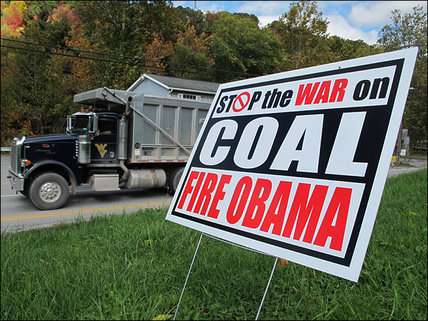Obama's War on Coal Is Unconstitutional, Says Harvard Law Professor Laurence Tribe
Maybe Congress can't "turn back the clock" on the EPA's lawless Clean Power Plan, but the courts may well do so.

As part of his efforts to address the menace of climate change, President Obama directed the Environmental Protection Agency (EPA) to devise a Clean Power Plan (a.k.a. the War on Coal) that aims to force states to cut carbon dioxide emissions from electric power generation plants by 30 percent below their 2005 levels by 2030. The EPA claims that its new regulations "will lead to climate and health benefits worth an estimated $55 billion to $93 billion in 2030." Regulations evidently produce only benefits, never costs.
On the other hand, a study by the consultancy Energy Ventures Analysis commissioned by Peabody Energy calculates that the Clean Energy Plan will boost annual power and gas costs for residential, commercial and industrial customers by $173 billion dollars in 2020 over what they paid in 2012, a 37 percent increase.
Quibbles over money aside; is what the EPA doing actually legal? Likely not. At least 12 states are now suing the EPA on constitutional law grounds to halt the imposition of the agency's new power plant regulations. Now, in a Wall Street Journal op-ed Harvard law professor Laurence Tribe agrees that the agency is acting unconstitutionally. From the op-ed:
…the EPA, like every administrative agency, is constitutionally forbidden to exercise powers Congress never delegated to it in the first place. The brute fact is that the Obama administration failed to get climate legislation through Congress. Yet the EPA is acting as though it has the legislative authority anyway to re-engineer the nation's electric generating system and power grid. It does not.
To justify the Clean Power Plan, the EPA has brazenly rewritten the history of an obscure section of the 1970 Clean Air Act. The EPA cites Section 111 of the Clean Air Act as authority for its proposal. In reality, this part of the law expressly says that it may not be used to regulate power plants where, as is the case in this situation, those plants are already being regulated as Congress contemplated under another part of the law, Section 112—one involving hazardous pollutants.
Last spring, the Supreme Court read the statute in precisely that way in Utility Air Regulatory Group v. EPA. The EPA acknowledges that the Clean Air Act "appears by its terms to preclude" its proposal. That is an understatement. And the problem can't be dismissed as a quirk in the statute. The language at issue has been a feature of the Clean Air Act for decades. That's why, in 2008 (New Jersey v. EPA), the D.C. Circuit struck down a far less ambitious EPA rule under exactly the same statutory constraint involved here. Today the agency is again circumventing the checks Congress deliberately built into the Clean Air Act and distorting it to justify a wide-ranging carbon rule in a way Congress never intended or authorized.
Frustration with congressional inaction cannot justify throwing the Constitution overboard to rescue this lawless EPA proposal—especially when the EPA itself, through Senate testimony by its administrator, Gina McCarthy, has touted its proposal as "an investment opportunity" that isn't really "about pollution control" at all.
In his State of the Union speech last night, President Obama vowed to continue his efforts to "combat climate change" and warned that he would "not let this Congress endanger the health of our children by turning back the clock on our efforts." Maybe Congress can't "turn back the clock" on the Clean Power Plan, but the courts may well do so.


Show Comments (46)